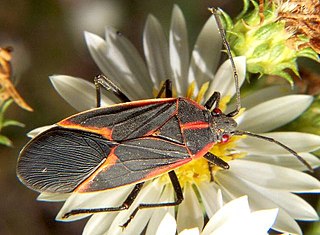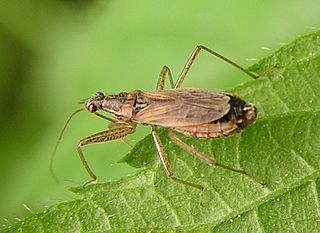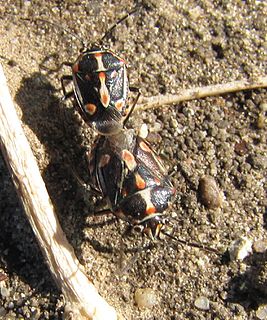
Parasteatoda tepidariorum, the common house spider, referred to internationally as the American house spider, is a spider species of the genus Parasteatoda that is mainly indigenous to the New World, with P. tepidariorum australis but has achieved a cosmopolitan distribution. American house spiders are synanthropic and build their tangled webs in or near human dwellings, greenhouses or similar, often in secluded areas such as between loose walls and behind open doors and attic windows. Statistically, they are the most often encountered spider by humans in North America, and least likely to adopt defensive behavior in their vicinity. Their prey mechanism is similar to that of the other cobweb spiders: the spider follows disturbances transmitted along the web to entangle and then paralyze its prey, which usually consists of household insects and other invertebrates.

The Pentatomoidea are a superfamily of insects in the Heteroptera suborder of the Hemiptera order. As Hemiptera, they share a common arrangement of sucking mouthparts. The roughly 7000 species under Pentatomoidea are divided into 21 families. Among these are the shield bugs, giant shield bugs, burrower bugs, and stink bugs.

The boxelder bug is a North American species of true bug. It is found primarily on boxelder trees, as well as maple and ash trees. The adults are about 12.5 millimetres (0.49 in) long with a dark brown or black colouration, relieved by red wing veins and markings on the abdomen; nymphs are bright red. This species recently invaded Chile, thus becoming an invasive species.
Magical creatures are an aspect of the fictional wizarding world contained in the Harry Potter and Fantastic Beasts and Where to Find Them series, both by British author J. K. Rowling. Throughout the seven books of the series, Harry and his friends come across many of these creatures on their adventures, as well as in their Care of Magical Creatures lessons at Hogwarts. The Care of Magical Creatures Class take care of creatures such as Hippogriffs, Unicorns and Owls. Rowling has also written Fantastic Beasts and Where to Find Them, a guide to the magical beasts found in the series. Many of these are derived from folklore, primarily Greek mythology, but also British and Scandinavian folklore. Many of the legends surrounding mythical creatures are also incorporated in the books. "Children ... know that I didn't invent unicorns, but I've had to explain frequently that I didn't actually invent hippogriffs," Rowling told Stephen Fry in an interview for BBC Radio 4. "When I do use a creature that I know is a mythological entity, I like to find out as much as I can about it. I might not use it, but to make it as consistent as I feel is good for my plot."

The western conifer seed bug, sometimes abbreviated as WCSB, is a species of true bug (Hemiptera) in the family Coreidae. It is native to North America west of the Rocky Mountains but has in recent times expanded its range to eastern North America, to include Nova Scotia, Maine, Connecticut, Massachusetts, and New Hampshire, and has become an accidental introduced species in parts of Europe.

The insect family Nabidae contains the damsel bugs. There are over 500 species in 20 genera. They are soft-bodied, elongate, winged terrestrial predators. Many damsel bugs catch and hold prey with their forelegs, similar to mantids. They are considered helpful species in agriculture because of their predation on many types of crop pests.

Pentatominae is a subfamily of Pentatomidae, a family of shield bugs. This subfamily is the largest one within the pentatomidae, having 4937 species. classified in 938 genera. Species on this subfamily are phytophages and several of them have been considered agricultural pests. Some invasive pentatomines such as Halyomorpha halys and Bagrada hilaris have been considered household pests, even inflicting adventitious bites. Higher systematics of the group has been revised by Rider et al.

Acanthosomatidae is a family of Hemiptera, commonly named "shield bugs," for which Kumar in his 1979 world revision recognized 47 genera; now this number is 55 genera, with about 200 species, and is one of the least diversified families within Pentatomoidea.

Leptoglossus is a genus of true bugs in the leaf-footed bug family and the tribe Anisoscelini. Species are distributed throughout the Americas, with some records in eastern & southern Asia and Europe. Several species are economic pests of agricultural crops. Like members of some other genera in the family, these bugs have leaflike dilations of the hind tibia. Several species are of economic importance, and one species, L. chilensis, has been reported to bite humans.

Bagrada hilaris is a species of shield bug known by the common names bagrada bug and painted bug (See a short video at YouTube). It could be mistaken for or erroneously referred to as harlequin bug. It is native to Africa. It is known elsewhere as an introduced species, including California and Arizona, where it was first reported in 2008. It is a major pest insect of Brassica oleracea crops, and related crucifers such as turnips, rape, and mustard. The adult and nymph of the species suck sap from the leaves of the plants, causing wilting, yellowing, and stunting of growth. Besides crucifers, the bugs are known on papaya, sorghum, maize, potato, cotton, caper, pearl millet, and some legumes. Large numbers of the bug congregate on the plants and cause extensive damage.

Stagonomus venustissimus, common name woundwort shieldbug, is a species of shieldbug belonging to the family Pentatomidae, subfamily Pentatominae.

The Dinidoridae are a small family of insects comprising about a hundred species in sixteen genera in the Hemipteran suborder Heteroptera, the "true bugs". As a group the family does not have any common name. Until the late 19th century they were generally regarded as a subfamily of the Pentatomidae.

Lycosa aragogi is a species of the araneomorph spider family Lycosidae endemic to Kerman Province, Iran. The female holotype measured 26 mm,, with two black and three white stripes of setae on its cephalothorax, black setae on its chelicerae, and scattered dots and patterns of black and white setae on its abdomen.

Lusius malfoyi is a parasitoid wasp found in New Zealand. The species is named for Lucius Malfoy, a character in the fictional Harry Potter series of books by J.K. Rowling, although the genus was described in 1903. The species is the first in its genus described in New Zealand; although the holotype specimen was captured in 1981, it was not described until 2017. The species is geographically widespread in New Zealand but rare.
Aname aragog is a species of trapdoor spider in the family Anamidae. It is found in the Pilbara region of Western Australia. The specific epithet is in reference to the spider Aragog in J.K. Rowling's Harry Potter books.
Graphorn is a genus of shield bug found in Argentina. As of 2018, it is monospecific, just consisting its type species G. bicornutus. The genus is named after the graphorn, a magical creature from the Harry Potter series.
Coenus is a genus of stink bugs in the family Pentatomidae. There are at least three described species in Coenus.

Chinavia is a genus of green stink bugs in the family Pentatomidae. There are more than 30 described species in Chinavia.













